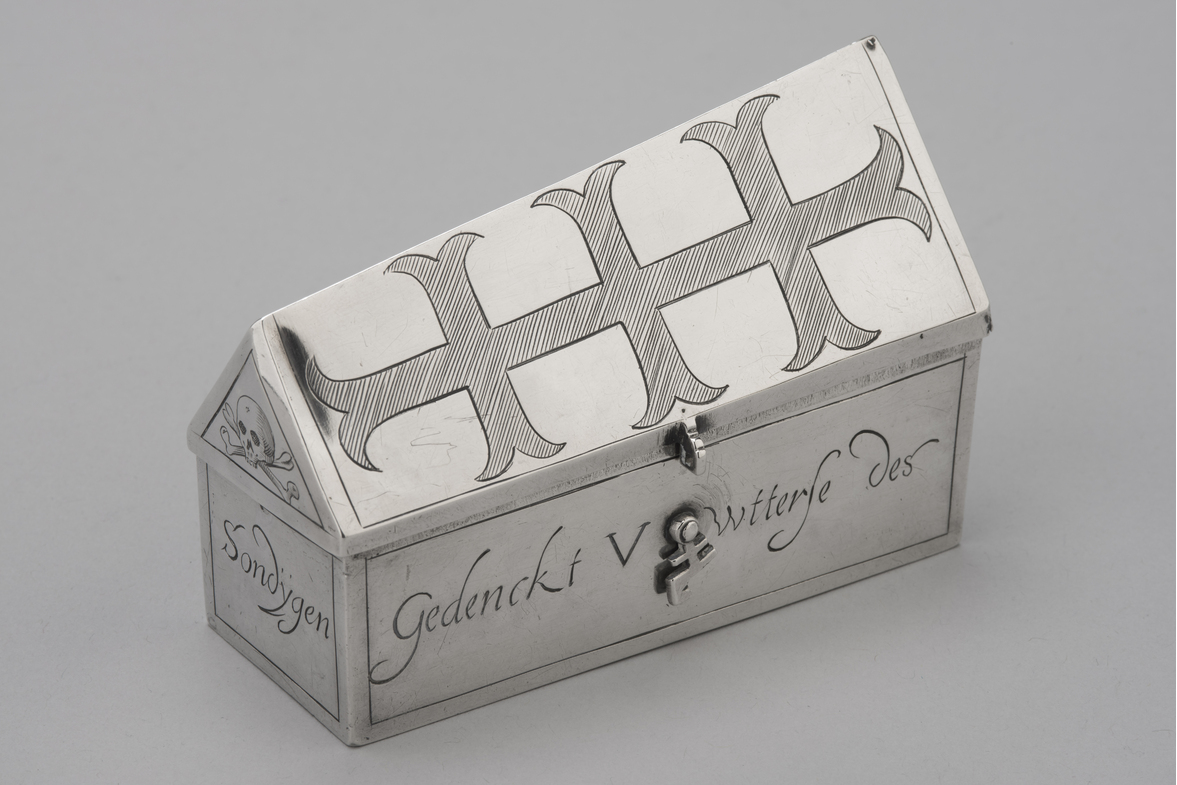When Catholics are no longer allowed to express their faith in public, their priests must be resourceful in order to bury the dead according to the traditional rituals.
Location
De Pool
Prins Hendrikkade 188C-5
Historic building demolished
Type
Hidden church
Religious community
Roman Catholic Church
Object
Small silver box in which consecrated ground was stored
Maker and date
P.C. Ebbekin
1651
Visit
Part of the permanent display in the Our Lord in the Attic Museum.
Burying the dead in consecrated ground
This mysterious little box is about 11 centimeters long and 4.5 centimeters wide. The outside is engraved with memento mori (Latin: remember that you must die). The text reminds the reader of human mortality. In the eighteenth century, it was used for hidden Catholic funeral rituals.
Gerardus van Wijckersloot was the pastor of the Roman Catholic hidden church De Pool between 1720 and 1727. When he had to visit the home of a deceased person, he wore inconspicuous clothing. After all, he was not allowed to be recognizable as a Catholic priest in public. Upon arriving at the house of the deceased, he would take this silver interment box from beneath his cloak. He then recited the traditional prayers for the deceased and sprinkled the body with holy water. Finally, he took the funeral box in his hands and cast three small scoops of the consecrated earth it contained into the coffin.
hidden church
Building in which hidden religious services were held in the Dutch Republic (1588-1795). Christian denominations outside the Calvinist church, such as Catholics, Lutherans, Mennonites and Remonstrants, had to practice their religions in hidden churches.
Pastor
(Latin for shepherd) is the priest, to whom the leadership of a parish (church) is entrusted by the bishop.
Holy water
Water blessed by a priest for use in blessings.
Consecrated ground
Ground that has been blessed and is therefore suitable for Christian burial.
A clever solution in times of oppression
After the Alteratie of Amsterdam in 1578, traditional Catholic rituals surrounding death could no longer take place in the former Catholic churches and cemeteries, as these had been taken over by the Reformed Church. Since Catholics were now not allowed to express their faith in public, their priests had to be resourceful. This small, easily transportable 'interment box' is a clever solution. With it, the priest could perform the necessary rituals in the home of the deceased—rituals that would have normally taken place in public. Afterward, the deceased could be taken to their final resting place without any Catholic religious display. Wealthy citizens were often buried at this time—usually for a fee—in a former Catholic church, preferably as close as possible to where the high altar once stood. Less affluent individuals are buried in a public cemetery.
Alteratie
In 1578, the Catholic city government of Amsterdam was deposed. A Protestant city council took its place. The consequence of this change (Alteratie in Dutch) was that, from that moment on, the Reformed Church became the only church that was allowed to manifest itself publicly. Catholic churches and monasteries were confiscated and given new functions.
High altar
The high altar is so called from the fact that it is the chief altar in a church, and also because it is raised on an elevated plane in the sanctuary.
''He casts three times some earth into the coffin'', text from an instruction for priests at Catholic funerals.
A. Van der Kruyssen, Misse, haer korte uytlegginge en godtvruchtige oeffeninge onder de zelve, neffens eenige besondere zegeninge, en het gebruyck der H.H. Sacramenten zoo die in de H. katholycke apostolycke Roomsche Kercke geoeffent worden (s.l. 1657).
Anouk Verhoeven
Student minor Religieus erfgoed in Amsterdam (Vrije Universiteit/Reinwardt Academie)
Last edited
June 23, 2025
Silver interment box from hidden church De Pool, P.C. Ebbekin, 1651. Collection Our Lord in the Attic Museum.
Exterior: photography Robert Westera.
De IJgracht 30-35, met in het midden op nummer 31 het Willige Rasphuis, Jan de Beijer, 1757, drawing. Collection City Archives Amsterdam.
Scanned page taken from: A. Van der Kruyssen, Misse, haer korte uytlegginge en godtvruchtige oeffeninge onder de zelve, neffens eenige besondere zegeninge, en het gebruyck der H.H. Sacramenten zoo die in de H. katholycke apostolycke Roomsche Kercke geoeffent worden (s.l. 1657).
Citroen, K.A., Haarlemse zilversmeden en hun merken (Haarlem 1988).
Frijhoff, W., Dynamisch Erfgoed (Amsterdam 2007).
Mudde, C.J., Rouwen in de marge. De materiële rouwcultuur van de katholieke geloofsgemeenschap in vroegmodern Nederland, Proefschrift Universiteit Utrecht (2007).
Roever, M. de en J. Bierenbroodspot, De begraafplaatsen van Amsterdam (Amsterdam 2004).
Online sources
Begraven in kerken
Last visited 23-05-2024








